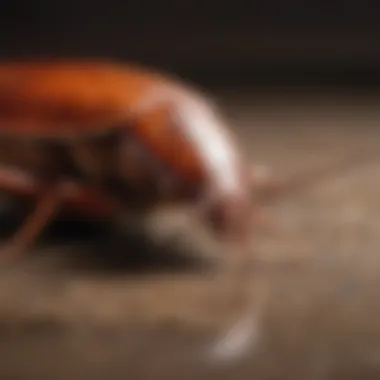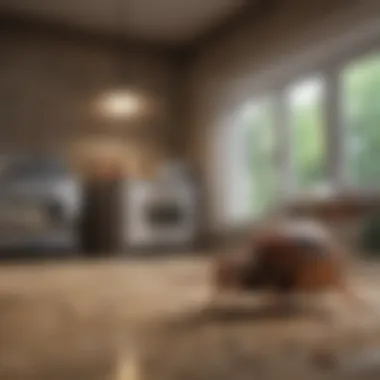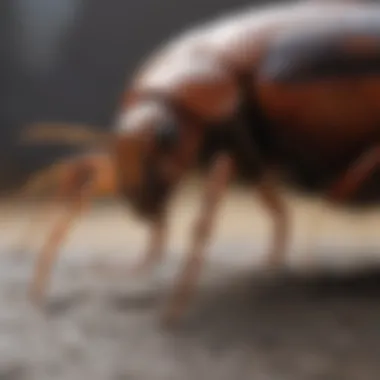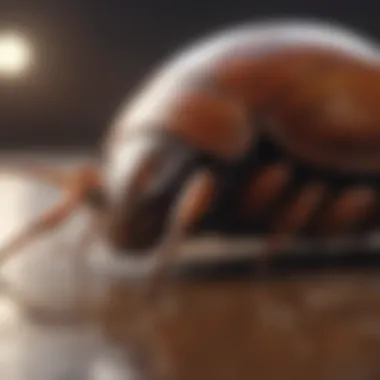Effective Strategies for Permanent Roach Removal


Intro
The presence of roaches in our homes is both an annoyance and a health risk. These pests can multiply quickly, making it essential to understand methods for their permanent removal. This article delves into the behavior of roaches, identifies how to prevent infestations, and outlines effective extermination strategies. By grasping the nature and habits of roaches, readers will be better equipped to maintain a roach-free environment.
Animal Overview
Common Name and Scientific Classification
Roaches, known scientifically as Blattodea, are a diverse group of insects. They encompass several species, with German cockroaches and American cockroaches being the most prevalent in urban settings. The diverse biological characteristics allow these insects to adapt well to various environments.
Physical Characteristics
Roaches typically have flat bodies and long, slender legs, making them agile. They possess long antennae that help in navigation and sensing environments. The color varies from light brown to dark brown or even black, depending on the species.
Habitat and Distribution
Roaches thrive in warm, humid environments, commonly found in kitchens and bathrooms. They can be located worldwide but prefer areas close to food and moisture. This preference makes homes and commercial kitchens ideal habitats for their existence.
Behavior and Social Structure
Communication Methods
These insects communicate mainly through pheromones, which are chemical signals that indicate food sources or danger. They can also use body language and sounds to warn others of threats.
Social Hierarchies
Roaches possess a simple social structure. They often congregate in groups, known as a colony. This behavior enhances their survival, as it provides protection from predators and increases their chances of finding food.
Mating and Reproductive Behavior
The mating process of roaches involves pheromonal signaling, and they can reproduce rapidly. A single female can produce dozens of eggs within their lifetime, leading to exponential population growth if not controlled.
Prevention Strategies
To prevent a roach infestation, consider the following:
- Seal Cracks and Openings: Close all entry points where roaches might enter.
- Keep Food Stored: Ensure all food items are stored in airtight containers.
- Maintain Cleanliness: Regular cleaning helps minimize attractants.
- Eliminate Standing Water: Fix leaks and remove stagnant water sources.
Maintaining a clean environment is crucial for preventing roach infestations.
Extermination Techniques
Various methods exist for removing roaches. These include both chemical and non-chemical approaches. Chemical options involve insecticides tailored to target roaches specifically, while non-chemical methods often use traps and baits. Baits can be particularly effective as they attract roaches and poison them before they can reproduce.
In summary, understanding the behaviors and preferences of roaches is vital for their permanent removal. Combining prevention with effective extermination methods can help restore and maintain a healthy living environment.
Understanding Roach Behavior
Understanding the behavior of roaches is crucial for developing efficient strategies to eliminate them. Roaches are resilient and adaptive creatures. Their habits, habitats, and interactions with their environment play a significant role in their ability to invade and proliferate within structures. Recognizing these patterns helps individuals target the most vulnerable areas in their homes, ensuring more effective extermination efforts. A thorough grasp of roach behavior can also aid in implementing preventative measures that discourage future infestations.
Biology of Roaches
Roaches belong to the order Blattodea, which comprises over 4,000 species. Their biology is characterized by a flat, oval body. Most species have long antennae and can be quite elusive. They have a segmented body structure that includes a head, thorax, and abdomen. Roaches typically have wings, but many species are not strong fliers. Their life cycle consists of three stages: egg, nymph, and adult.
Understanding this lifecycle is essential. For example, a single female roach can produce hundreds of offspring in her lifetime. This rapid reproduction rate stresses the importance of addressing infestations quickly.
Common Species of Roaches


While there are numerous species of roaches, several are prominent in urban settings. The American cockroach is one of the largest and commonly encountered. It thrives in warm environments and is often found in kitchens and basements. The German cockroach, smaller in size, reproduces quickly and is frequently found in homes and restaurants. Other notable species include the Oriental cockroach and the brown-banded cockroach. Each species has distinct behaviors and preferences, making it vital for homeowners to identify which type they are dealing with.
Roach Habitats
Roaches prefer dark, damp, and warm environments. Common habitats include kitchens, bathrooms, and any area where food and moisture are present. They often hide in crevices, under sinks, and behind appliances. Their tendency to congregate in groups adds to their resilience. Ensuring that these habitats are inaccessible is a key step in preventing infestation. Places that provide shelter and proximity to food should be targeted for thorough cleaning and monitoring.
Roach Feeding Patterns
Roaches are omnivorous scavengers. They consume a diverse range of organic materials, including food scraps, grease, and even non-food items, such as paper and fabric. This adaptability allows them to thrive in various environments. Understanding their feeding habits can inform effective management strategies. Foods high in sugar and starch tend to attract them, underscoring the importance of proper food storage and waste management as preventative measures.
Effective pest management relies on understanding the ecology and behavior of the target species.
By acknowledging these biological and behavioral characteristics, homeowners can effectively devise and implement strategies to achieve complete and permanent roach elimination.
Identifying Infestation Signs
Identifying infestation signs is a critical step in managing roaches. Recognizing these signs early can mitigate potential damage to your home and help in devising a swift extermination strategy. Much of the success in removing roaches relies on understanding their activity patterns and their preferred environments. By knowing what to look for, homeowners can tackle the problem before it escalates into a more significant infestation.
Common Signs of Roach Presence
There are notable signs that indicate the presence of roaches in your living space. These include:
- Droppings: Small, dark specks that resemble pepper or coffee grounds often indicate roach activity. You may find them in areas where roaches tend to congregate, like under sinks, behind appliances, or inside cabinets.
- Egg Cases: Cockroach egg cases, or oothecae, are usually brown and oval-shaped, containing multiple eggs. They can be found in hidden spots where roaches like to breed.
- Shed Skins: Roaches shed their skin several times during their growth stages. Finding these lifeless shells could indicate an active population nearby.
- Musty Odor: A pervasive, unpleasant smell can arise from a significant roach presence. They release pheromones that create this odor, usually detected in heavily infested areas.
Recognizing these signs early not only helps in identifying their hiding places but also aids in developing an effective extermination plan.
Inspecting Your Home
Thorough inspection of your home is essential to confirm the presence of roaches. This process involves examining potential hiding spots meticulously and understanding the factors contributing to the infestation. Here’s how to conduct a comprehensive inspection:
- Start in Kitchens and Bathrooms: These areas are common for roach activity due to the availability of food and moisture. Check under the sink, behind appliances, and in the corners of cabinets.
- Move to Living Areas: Look behind furniture, around electrical outlets, and inside bookshelves. Roaches can easily hide in cluttered spaces.
- Check Entry Points: Inspect doors, windows, and any cracks for signs of entry. Seal any identified gaps to prevent further access.
- Look in Dark Spaces: Roaches prefer dark areas during the day. Inspect basements, attics, and areas behind large appliances.
Maintaining vigilance during inspections can help establish a clearer picture of the extent of the infestation, enabling you to choose the most effective control methods.
Preventative Measures
Preventative measures play a crucial role in maintaining a roach-free environment. By engaging in proactive strategies, homeowners can significantly reduce the likelihood of infestations. The benefits of implementing these measures include less reliance on chemical treatments, lower costs associated with pest control, and an overall healthier living space. It is essential to have a firm understanding of the factors that attract roaches and how to counter these influences. Addressing the problem before it escalates is key to effective pest management.
Maintaining Cleanliness
A clean home is the first line of defense against roaches. Reducing potential food sources and nesting areas requires regular cleaning routines. Focus on the following:
- Frequent Vacuuming: Ensure floors, carpets, and corners are regularly vacuumed to eliminate crumbs and hidden food particles. This task should be done at least once a week.
- Wipe Surfaces: Every day, countertops and tables should be wiped down to remove food residues. Special attention should be given after meal preparation or consumption.
- Store Food Properly: All food items must be stored in tightly sealed containers. This practice helps prevent access to roaches and minimizes attractants.
Maintaining cleanliness can diminish the likelihood of a roach infestation significantly.
Sealing Entry Points
Identifying and sealing entry points is another effective measure in preventing roach access to your home. Roaches are remarkably agile and can penetrate through tiny openings.
Consider these points:
- Inspect Foundations: Look for cracks in walls or openings around pipes and vents. Smaller gaps should also be addressed to minimize potential entry.
- Use Caulking: Apply a high-quality sealant around windows, doors, and areas where pipes enter the home. This prevents roaches from finding their way inside.
- Repair Screens: Ensure that any window or door screens are intact and free from holes. Damage in screens can offer entry access to pests.
By sealing these points, you reduce the risk of roaches entering your home and creating nests.
Proper Waste Management
Effective waste management is imperative in discouraging roaches. Simply put, if trash is not managed correctly, it becomes a feast for unwanted pests.


Here are some strategies:
- Secure Trash Containers: Use bins with tight-fitting lids. This limits exposure to roaches and keeps odors contained.
- Regular Disposal: Make it a habit to empty trash bins, especially those in kitchens and bathrooms, at least several times a week.
- Compost Carefully: If you compost organic waste, do so in sealed compost bins to mitigate attraction.
By managing waste properly, you create an environment that is less hospitable to roaches and other pests.
Implementing proper preventative measures is key to eliminating the chances of a roach infestation.
Chemical Extermination Methods
When it comes to achieving a roach-free environment, chemical extermination methods are an essential aspect of the overall strategy. They offer immediate and powerful solutions to effectively reduce roach populations. However, understanding how these methods work is critical for ensuring their safe and optimal use.
Chemical methods generally involve the application of insecticides that target the physiological systems of roaches. Their effectiveness stems from the ability to interrupt key processes within the roach's biology. This method is particularly beneficial when dealing with a significant infestation where quicker results are necessary. Even though chemical options can produce fast results, they come with considerations such as potential health risks to humans and pets, environmental impact, and the necessity for proper application techniques. It is important to choose the right product based on the level of the infestation, the environment, and the presence of other inhabitants.
Insecticides and Their Application
Insecticides are chemical substances used to kill insects, and they are available in various forms, including sprays, granules, and dusts. The choice of insecticide often depends on the infested area and personal preferences. Here are some key points regarding their application:
- Types of Insecticides: There are two main categories: contact insecticides that kill on contact and ingestible insecticides that are consumed. Both serve different roles in extermination.
- Targeting Nest Locations: To maximize effectiveness, locate their nesting sites and apply insecticides directly there. This ensures that you are eliminating the source of the problem.
- Safety Precautions: Always follow the instructions on the label. Use protective gear, and ventilate the area before and after application to reduce exposure to harmful chemicals.
Insecticides can greatly aid in diminishing roach numbers when appropriately utilized.
Using Baits Effectively
Baiting offers a strategic approach to combatting roaches. Unlike traditional sprays, baits entice roaches to consume poison, which they may then carry back to their nests, potentially affecting other members of their population. Here are some effective practices to consider:
- Placement is Key: Position baits in areas where roach activity is observed, such as kitchens and bathrooms. Common locations include behind appliances, inside cabinets, and under sinks.
- Choose the Right Bait: Utilize bait stations that attract roaches. Look for options that combine both attractive bait and slow-acting insecticides. This allows the roach to return to the nest, increasing the likelihood of affecting more roaches.
- Monitor and Replace: Keep an eye on the bait stations. If they are depleted or fail to capture roaches, it may indicate a need for a different strategy or more aggressive measures.
Using baits can lead to effective results when employed intelligently and consistently.
Fumigation Options
Fumigation is often viewed as a last resort due to its extensive procedures, yet it can provide significant relief against severe infestations. Fumigation involves sealing the entire area to treat it with gaseous pesticides. This method penetrates even the most hidden spaces. Here are considerations about fumigation:
- Comprehensive Treatment: Fumigation is capable of reaching hidden areas like wall cavities and attics. This quality makes it a favored method in large-scale infestations.
- Professional Help Needed: Due to the complexities and health risks associated with fumigation, hiring a certified pest control professional is essential. They possess the required tools and expertise to execute this method safely.
- Preparation is Crucial: Prior to fumigation, homeowners must remove all food items, plants, and medications to avoid contamination. Any living beings, including pets, need to be relocated.
Fumigation can yield significant benefits when executed under expert supervision and with proper preparation.
Conclusion: Chemical extermination methods, when applied judiciously, can be powerful tools against roaches. Each method possesses its advantages, tailored to fit various levels of infestation and specific circumstances. Relying on professional guidance can enhance the effectiveness and safety of these methods.
Non-Chemical Solutions
Non-chemical solutions play a crucial role in the effort to permanently remove roaches from homes and other spaces. They offer a variety of benefits, such as reduced health risks associated with chemical exposure, environmental sustainability, and often lower overall costs. By implementing non-chemical strategies, individuals not only target the immediate issues posed by roach infestations but also contribute to long-term prevention through behavioral and habitat modifications.
In this section, we will focus on three primary non-chemical approaches: natural repellents, diatomaceous earth, and traps and monitors. Each of these methods has unique properties and effectiveness, which makes understanding their applications vital for anyone dealing with roach problems.
Natural Repellents
Natural repellents provide an eco-friendly way to deter roaches without using harmful chemicals. Many common household ingredients serve as effective deterrents. For instance, substances like peppermint oil, lavender oil, and vinegar can emit scents that repel roaches. These natural solutions are often easy to obtain and can be used directly in infested areas.
When considering natural repellents, it's essential to apply them consistently. A mixture of water and essential oils can be sprayed around entry points and suspected habitats. This proactive approach not only hinders roach movement but also reduces chances of a re-infestation.
Natural repellents are a safe alternative for homes with children and pets, offering peace of mind along with pest control.
Diatomaceous Earth
Diatomaceous earth is a powdery substance made from fossilized algae. It works by damaging the exoskeleton of roaches and dehydrates them over time. Unlike traditional insecticides that target the nervous system, diatomaceous earth is non-toxic to humans and pets, making it a favored option among non-chemical solutions.
To effectively use diatomaceous earth, one should:


- Sprinkle it in areas where roaches are likely to travel.
- Ensure a sufficient layer is present in cracks, crevices, and dark spaces.
- Reapply after cleaning, as moisture can reduce its efficacy.
The granules are so fine that they can easily integrate into areas where roaches hide, providing a constant barrier against their movement.
Traps and Monitors
Traps and monitors offer another effective non-chemical approach to manage roach populations. These devices can capture roaches while helping to identify levels of infestation. Sticky traps, for example, can be placed in strategic locations to monitor activity. By checking these traps regularly, homeowners can gain valuable insights into when and where roaches are most active.
Using traps effectively involves:
- Placing them in areas where roaches frequently hide, such as under sinks and behind appliances.
- Monitoring them regularly to evaluate the severity of the problem.
- Disposing of trapped roaches to prevent odors and further attraction.
In summary, non-chemical solutions provide viable options for combating roach infestations. They offer safety, sustainability, and, when used correctly, recucur resources that can lead to long-term sustainability in maintaining roach-free environments.
When to Seek Professional Help
In severe situations, homeowners must consider when to seek professional help for roach infestations. Understanding the complexity and urgency of an escalating roach problem can make a significant difference in achieving a long-term solution. Professional pest control services offer specialized knowledge, tools, and methods that are often beyond the reach of average household solutions.
It is essential to recognize that not all infestations are the same. For some, a few simple traps may resolve the issue. However, in cases where evidence of an extensive infestation exists, professional help becomes crucial. Here are some key points that illustrate when intervention from a pest control expert may be necessary:
- Extent of the Infestation: If the presence of roaches is widespread, often spotted in multiple environments, it indicates a larger problem. Egg cases, droppings, or a significant number of sightings highlight the need for professional treatment.
- Inability to Control the Issue: When DIY methods, such as traps or sprays, fail to yield results, it may be time to seek assistance. Persistence of roaches despite personal efforts can signal the need for advanced measures.
- Health Risks: Roaches are carriers of various diseases. If you notice health impacts such as allergic reactions or respiratory issues, professional extermination might be necessary for safety.
Aftercare Following Extermination
After successfully dealing with a roach infestation, many individuals often overlook the importance of aftercare. This stage is critical for ensuring that the problem does not arise again. Implementing effective aftercare practices significantly enhances the likelihood of maintaining a roach-free environment. Let’s examine the specific elements involved in aftercare, its benefits, and several considerations homeowners should keep in mind.
Continued Monitoring
Once the extermination process has been completed, continued monitoring becomes essential. This involves both visual checks and routine inspections of areas previously identified as hotspots for roach activity. Homeowners should remain vigilant for several weeks following treatment. Signs to look out for include droppings, egg cases, and even occasional sightings of living roaches.
- Keeping a log of any findings can be useful.
- Use traps strategically placed around the home to detect any returning roaches.
- Pay attention to previously infested areas and ensure that they remain free from pests.
By monitoring diligently, any resurgence of roaches can be identified early and re-addressed promptly. This can prevent more extensive issues from developing down the line.
Reinforcing Preventative Measures
After extermination, reinforcing preventative measures is equally important. The focus here is on practices that remove conducive conditions for roaches, which may include:
- Regular cleaning: Maintain a clean living environment by sweeping and vacuuming regularly.
- Food storage: Ensure all food is stored in airtight containers. This minimizes availability to roaches.
- Moisture control: Fix leaks and reduce humidity, as roaches are attracted to damp environments.
Homeowners should reassess their strategies frequently to confirm their effectiveness. It may be necessary to adapt current methods depending on seasonal changes or new developments in the household.
Thus, a combination of continuous monitoring and rigorous application of preventative measures forms the backbone of comprehensive aftercare following extermination. Implementing these techniques can greatly increase the chances of creating a long-term roach-free sanctuary in your home.
Ending
Summarizing Effective Strategies
In summary, successful roach elimination requires a multifaceted approach. Here are the key strategies discussed in this article:
- Identifying signs of infestation early: Spotting droppings, shed skins, or evidence of damage can help in taking action before the problem escalates.
- Chemical and non-chemical methods: Utilizing insecticides, baits, traps, and natural repellents is essential. Knowing when and how to apply these methods is critical.
- Preventative maintenance: Keeping spaces clean, sealing entry points, and managing waste is also fundamental in deterring future infestations.
Each method contributes to an effective extermination strategy, ensuring that roaches do not return once removed.
Long-term Commitment to Roach Prevention
Preventing a resurgence of roaches demands ongoing commitment. Households need to establish routines that emphasize cleanliness. This involves frequent cleaning, particularly in areas like kitchens and bathrooms where food and moisture may attract roaches.
Regular inspections of common entry points like cracks, gaps in walls, or openings around pipes can aid in early detection and prevention. Utilizing products like diatomaceous earth or other natural repellents as a part of the maintenance routine reinforces defenses against roaches.
Ultimately, a proactive mindset towards roach management will result in a sustained effort to keep spaces free from these pests. By understanding and implementing these strategies, families can cultivate an environment that discourages infestations, leading to peace of mind and comfort at home.
"An ounce of prevention is worth a pound of cure."
Implementing these strategies requires awareness and vigilance, forming a robust barrier against the potential return of these unwanted guests.







